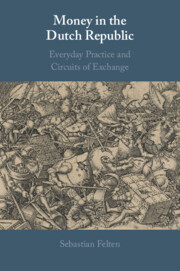Book contents
- Money in the Dutch Republic
- Money in the Dutch Republic
- Copyright page
- Dedication
- Contents
- Figures
- Tables
- Acknowledgements
- Introduction
- 1 Money as Social Technology
- 2 Grain Money in a Farming Community
- 3 Ink Money in a Princely Estate
- 4 Metallurgy and the Making of Intrinsic Value
- 5 Mercantile Practice and Everyday Use
- 6 Patriotic Economics and the Making of a National Currency
- Conclusion
- Appendix
- Archival Sources
- References
- Index
4 - Metallurgy and the Making of Intrinsic Value
Published online by Cambridge University Press: 03 March 2022
- Money in the Dutch Republic
- Money in the Dutch Republic
- Copyright page
- Dedication
- Contents
- Figures
- Tables
- Acknowledgements
- Introduction
- 1 Money as Social Technology
- 2 Grain Money in a Farming Community
- 3 Ink Money in a Princely Estate
- 4 Metallurgy and the Making of Intrinsic Value
- 5 Mercantile Practice and Everyday Use
- 6 Patriotic Economics and the Making of a National Currency
- Conclusion
- Appendix
- Archival Sources
- References
- Index
Summary
Chapter 4 explores how artisanal knowledge helped sustain early modern monetary order by making and unmaking the intrinsic value of precious metal. Intrinsic value was a conceptual tool and a material practice that allowed people to collapse many coins into one another and to forge units from multiples. Effectively, this meant establishing a network of corresponding values between specific batches of coins. The papers of a family of assayers from The Hague offer a fine-grained picture of the processes involved. Small differences in the precious metal content of coins aroused creeping suspicion, anger, and even physical violence because it was believed that the metal of a coin reflected the mettle of a person. This was particularly true for the masters of the mint, whose reputation was tied to the reputation of their coins. Making coins, and making them work, involved financial and legal expertise, but the artisanal knowledge of assayers and other metal-workers was key. Their practices such as sampling, using high-precision balances and powerful acids, note-taking, the rule of three, and algebraic calculation allowed people to hold on to the convention that metals had an intrinsic, quantifiable value in spite of fluctuations in the price of silver and gold, both across time and across the globe.
Keywords
- Type
- Chapter
- Information
- Money in the Dutch RepublicEveryday Practice and Circuits of Exchange, pp. 95 - 135Publisher: Cambridge University PressPrint publication year: 2022

